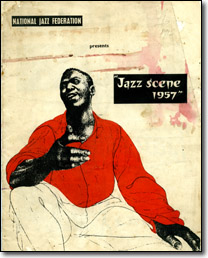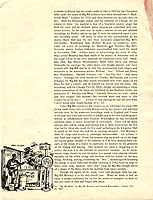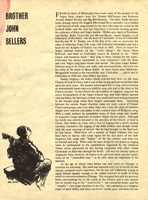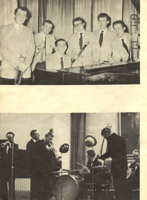|
||
BIG BILL BROONZY |
||
Page 4 |
||
William Lee Comley Broonzy was born on the 29th of June 1893 at Scott, Mississippi, into a large family in which he was one of sixteen children. "Born in Mississippi, raised in Arkansas", he moved to the latter State at an early age, and as soon as he was able was put to work on the land. In his early years Big Bill worked as a plough-hand, raised cotton and "eye-crops", felled timber, laboured on the levee. As a member of a section gang he "lined track" on the railroads with "Sleepy John" Estes, destined to be one of the greatest of blues singers, as his gang leader. All this time he learned scores of folk songs and blues and began to establish his own reputation as a singer. As a child he had made himself a one-string fiddle out of a cigar-box and broom handle, and when he obtained a guitar he soon became extremely proficient on the instrument. From local artists, from itinerant musicians and from his "uncles" about whom he tells many amusing stories, he extended his technical range and his repertoire of songs. In 1920 Big Bill Broonzy moved to Chicago where he found employment with the Pullman Car Company. There, in a more urbanised environment he might well have been unhappy, but Chicago at that time was the centre to which thousands of Negroes gravitated and he soon met up with such great folk blues singers as Blind Blake, Blind Lemon Jefferson and Arthur Pettis. A number of these artists had already recorded and they persuaded Bill to do likewise. His first recorded piece was a guitar solo, "House Rent Stomp", and this is still a favourite tune of his today. This, with three other blues, he recorded for Paramount in 1926, and a couple of years later he made two further sides under his own name for the same company, together with a number of recordings with the "Hokum Boys" who included Pettis, "Georgia Tom" Dorsey and Mozelle Anderson. Unfortunately, none of these early recordings are ... |
||
Today Big Bill returns to this country as an old friend, for since 1950 he has made three visits to Great Britain and by his concerts and informal sessions here, by his numerous recordings made in England and France in the post-war years and currently available, and by his own autobiography written in collaboration with Yannick Bruynoghue he has introduced authentic blues to many thousands of enthusiasts. There will be many persons who will be seeing and hearing him at these concerts for the first time but for those who recall the first small gathering at the Kingsway Hall as much as for them this will be an exciting occasion. For Broonzy's fund of songs and stories is seemingly inexhaustible; his artistry is ever fresh and original. From the moment that he strolls on to the stage waving his guitar amiably to the audience as if he were meeting them casually at the house of a friend he captivates his listeners by the greatness of his singing and playing. One moment his voice is staggering in its power, the next it is the epitome of expressive restraint. As he hums, moans, sings, shouts, he uses his guitar as a second voice, playing intricate melodies on the treble strings and rhythms with his thumb on the bass string. Stroking, picking, strumming the "box", slackening and tautening the strings to make them wail he adds meaning to every word he sings in blues, work song, spiritual—and "pop" song, for Big Bill, though above all a singer of the blues, draws his material from many sources. Though fhe agility of his mind, voice and physique belie his age, Big Bill Broonzy is in his sixty-fourth year. When we listen to him we enjoy a unique experience for he has the power to transport us back to the very roots of Jazz and Negro folk music. |
||
Pages 8, 10, and 12 [Note: The original programme contained printing errors which resulted in several paragraphs appearing out of sequence. These errors have been corrected here, and the three original pages of text have been merged.] |
||
Deeply religious, the Sellers family centred their lives on the local Church of God in Christ, and it was in this strong spiritual world that John spent his early years. His parents encouraged him to sing, and possessing an uncommonly sweet voice as a child he sang solo and in the choir in the Church services. In the Church the old tradition of religious song and the newer developments of the Negro Church met, and John Sellers learned with the Elders the Spirituals of their own youth and heard and participated in the Gospel songs which have largely superseded them. Travelling between the various Negro churches today are many scores of Gospel Choirs and groups, and even when John was a boy the visits of itinerant singers were welcome and added to the common store of Religious song. With a ready memory he assimilated many of these songs and steadily he acquired a large repertoire of modern Negro church music. Although his family was entirely devoted to the activities of the Church of God in Christ, John Sellers as a boy with a love of singing and a child's natural curiosity, listened to the singing of the field workers and plough hands with the same intensity of interest that he had brought to the Spirituals he had heard. There were still a number of Negro veterans who had been born in slavery who could repeat for his ears many of the half-forgotten folk songs and "ballets" of the last century, and these too he learned and sang. When only ten years of age he won prizes in singing when he participated in the competitions organised by the Amateur Talent shows sponsored by the touring companies that often visited Clarksdale on their way through the South. Life was not entirely spent in singing for John, however; he had to work and work hard, and the experiences of his "cottonfield days" as he calls them are engrained in his memory. At the age of eleven John Sellers was sent north to Chicago to continue his schooling. His mind had matured early, for in his life he had already crammed much experience, but he was still sufficiently young to adapt himself happily enough to the violent contrast in mode of living which he now encountered in Chicago. The strongest link with his previous home surroundings lay in the world of the Church and it was natural that he should sing in the "store-fronts"—the converted shops, and the "temples"—the larger churches in the City. His reputation as a religious singer of great ability and deep conviction rapidly grew, and when he was still in his teens John Sellers met Mahalia Jackson. He was known within the Church as "Brother" John Sellers, for in the Southern churches it is customary for male and female members to address each other respectively as "Brother" and "Sister." Though the practice is not as universal in the Northern churches, John Sellers was known exclusively as "Brother John," and it was by this name that he was known when he met Mahalia Jackson. For Brother John the experience of meeting and singing with the great religious singer was a profound one. Dividing her time between the Baptist Church, and with characteristic realism, the beauty parlour that she owned, Mahalia Jackson was then as she is today an impressive and influential personality. On the impressionable young singer her influence was not inconsiderable, but whilst she enabled him to increase both his range and his repertoire, he retained his individuality and developed his own personal qualities. On some of Mahalia Jackson's recordings Brother John participated but, as he recalled, "I have sung with her on records in the background along with other singers where you would not know my voice from any other singers." He soon recorded under his own name, however, commencing with a session for Victor when he was only twenty-one and following this with other records for such labels as Southern and Miracle during 1948. For the latter label he recorded the fine old spiritual "Precious Lord" and cut "Move Up a Little Higher" a year before Mahalia Jackson recorded the Gospel song. Though nearly all his early recordings were of religious items, Brother John began to record more secular songs and blues during and after 1950. Living in Chicago had brought him in contact with many blues singers of various types and he had opportunities to listen to recordings of earlier men. His interest in the secular music and song of his race had not waned from his childhood days and he found no difficulty in accepting the blues as a genuine form of self-expression, without impairing the sincerity of his work in the Religious field. He heard and admired greatly such singers as Big Bill Broonzy and Memphis Slim as well as his younger contemporaries such as Pleasant Joe and began to absorb their idioms. His extremely receptive mind allowed him to do this, but the confusion that was almost inevitable was reflected to a certain extent in his recordings. More than half his life had now been spent in Chicago and not unnaturally he was drawn increasingly to the field of rhythm and blues, the rapidly developing modern extension of the blues form. Brother John's big opportunity to establish a career as a professional singer came in 1950 when Big Bill Broonzy made his European tour. At the time the engagement was booked Broonzy was working at the "Blue Note" Club at No. 56 West Madison Street in the centre of the Loop between North State and North Dearborn. When Big Bill left for Europe it was Brother John who took his place. In his repertoire he included folk songs, ballads, blues, Gospel songs and spirituals which he drew from the considerable volume of material which he had gathered in past years. Recalling his childhood days he was able to recount stories and supply the background to many folk themes that were quite new to his listeners and he became increasingly popular. Engagements followed in Chicago and New York and one or two record sessions with "Schoolboy" Porter, King Kolax and other musicians scarcely known in Great Britain, but he sometimes fell on hard times, for there is no primrose path for a blues singer who is not prepared to compromise his material. Early in 1954 Brother John made the recordings which have been issued in this country on Vanguard PPT 12008. They are the only examples of his work that are available here and varying from the Gospel song "Two Little Fishes, Five Loaves of Bread" to the ballads of "John Henry" and the "Boll Weevil" and the modern R & B numbers, they demonstrate his versatility. The accompanying group which includes Sir Charles Thompson and Ruby Braff is not an ideal one either for the material chosen or for the singer himself. A year later he recorded a second session for Vanguard with the little-known guitarist Johnny Jones and the famous folk harmonica player Blind Sonny Terry. On these recordings he appears as a mature singer, versatile and spirited. "Sally Go Round the Sunshine" is a children's ring game which recalls Brother John's Mississippi background, whilst "Jack O'Diamonds" is the ancient folk gambling blues which was first recorded by Blind Lemon Jefferson. Other tunes are spirituals and blues which amply demonstrate Brother John's abilities and give some hint of the range of Negro folk song both sacred and secular which he can introduce to British audiences. After a spell in New York early in 1956 Brother John spent the Summer and Autumn in Montreal, Canada, where he was well received and appeared regularly in Clubs and from time to time on Television. He has looked forward with enthusiasm to his visit to Great Britain and we in turn can look forward with pleasurable anticipation to the experience of hearing from one of their most youthful and talented exponents those Negro folk songs which continue to flourish and develop today in contemporary America in spite of all prophesies to the contrary. That it should continue to do so is due in no small measure to the work of Brother John Sellers. |
||
Page 15 |
||
Chris and his Band really need no introduction to a jazz audience. They are nowadays acknowledged as holding the top position in Britain's traditional world. The reign of Humph the King was at first dented and then ended last year when the Lyttelton Band was headed for the first time in a national popularity poll by the Chris Barber Band. Success for the band has developed phenomenally, without recourse to gimmicks or publicity stunts. Nobody gyrates hips or knees self-consciously on stage—though Monty will occasionally indulge himself with a little hand-clapping. Today, the band's records sell on a par with the better "pops" and membership of the Chris Barber Club, which has no headquarters or raison d'etre other than an admiration for the band's music, runs into thousands. Chris himself in his off-stage moments seems the most unlikely man to have inspired this success, for he is self-effacing and often a little hesitant. He sports none of the gaudy personality that is so often associated with entertainers. So far as is known he has never grown a beard. He is 26 years old, and birthday cards should be addressed to arrive on April 17th. His hobbies all centre on his music, apart from a craving for sports cars, and he has recently graduated from vintage Lagondas to a sleek and windswept Lotus. Although this is not Chris's first band, it is the only one which has met with real success. His earlier bands were, in effect, dummy-runs, in which he worked out his musical formula and gained experience. The present band was formed in June, 1954, by the split-up of the Ken Colyer Band into two pieces. Whether Ken fired the rest of the band or the rest of the band fired Ken is now a matter for conjecture—no matter, the result was sure. Of the original group of musicians who comprised the band in those days, all remain except for two of the rhythm section. A series of guitar players, including Lonnie Donegan, Dick Bishop and Johnny Duncan, have moved into the band—developed a talent in the skiffle group, and then moved on to the lucrative world of Rock-'n'-Roll. The latest recruit to the band is, in fact, banjo player Eddie Smith. He joined at the end of last year after a stretch with Mike Daniels. The rest of the rhythm section consists of another Smith (this one called Dick) on bass and drummer Ron Bowden, the latter being a founder member. Both Monty Sunshine on clarinet and Pat Halcox on cornet have developed strong fan followings on their own account. Both are forthright musicians and their collective personalities are an essential part of the band. Without them the Barber Band as it is today would not exist. In Ottilie Patterson the band has the undoubted asset of Britain's finest blues singer. She joined the band by chance, and deserted a schoolroom full of children in order to do so. Ottilie and the rest of the band form Britain's outstanding traditional jazz alliance. |
||
Page 17 |
||
APPEARING AT NOTTINGHAM, NEWCASTLE & GLASGOW Mick Mulligan and George Melly have been a jazz partnership for as long as there has been a British jazz movement. Always they have been the centre of the ravers and always they have been worth hearing. At times the music was not so good, but at least everyone had a whale of a good time. Since its formation, Mick's band has housed a collection of jazz notables, not least of whom is the band's manager, Jim Godbolt. Bob Dawbarn, who has now slipped into the respectability of writing features for the "Melody Maker", used to play trombone with the band, and Paul Simpson, now leading his own band, was a one-time clarinet and saxophone player with them. This was at the height of the "Raving Period," when "Da-Da", personified in the shape of George Melly, terrified club and concert promoters throughout Britain. One remembers his appearance through a "prop" fireplace in the back scenery during a Festival Hall concert. Of late an air of respectability—one hesitates to use the word pedestrianism—has crept into the band's life. George Melly looked set to emulate Lonnie Donegan when his record of "Kingdom Come" slipped into the best sellers' list, and on several recent concerts the musical content of the band's performance has well-nigh stolen the show. This band deserves all of your attention. KEN COLYER'S JAZZMEN APPEARING AT THE ROYAL FESTIVAL HALL, LONDON Ken Colyer has taken a lonely path through British jazz. That is if one discounts the near fanatical support of the purist section of British jazz appreciation. He has sacrificed one band after another on the altar of his ideals, and his perseverance has been rewarded. He has been the main propagandist for the return to the roots of jazz. In the early days he was, in fact, the only propagandist. He felt that he had welded the right group together when the Crane River Band was growing, but as its popularity developed and its approach broadened, it finally detoured from Ken's chosen path. When he returned from New Orleans, his convictions had been strengthened by actual contact with the George Lewis Band and its contemporaries. How strong these convictions are is clearly shown by his action in jettisoning his band when it was receiving national acclaim. Ken's present band has been built up painfully and carefully and he is happier with the jazz it is producing than that of any other of his bands to date. His attention is now turning to the development of a British marching band; and this has appeared in several concerts and has actually paraded through Soho during the annual fair. It is large, impressively different and a typical product of Ken Colyer's drive and integrity. |
||





